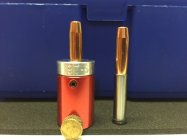OK what this tool actually compares is ogive profile variance.
the stem inside the tool is made to match most seater stems, obviously it can't perfectly match every stem from every manufacturer.
The body of the tool is reamed with a lead/throat that i believe is most common for that caliber, once again it cant be a perfect match for ever chamber.
WHat we are looking for is variation, were not measuring anything.
We sort into sublots by ogive profile.
The end result is a consistant seating depth for each sublot.
It has been my experience that a .003-.005 variation in seating depth can be significant and bearing surface variance is not even worth taking the time type the words.
A .040 variation in BS had no affect on my long range loads.
the stem inside the tool is made to match most seater stems, obviously it can't perfectly match every stem from every manufacturer.
The body of the tool is reamed with a lead/throat that i believe is most common for that caliber, once again it cant be a perfect match for ever chamber.
WHat we are looking for is variation, were not measuring anything.
We sort into sublots by ogive profile.
The end result is a consistant seating depth for each sublot.
It has been my experience that a .003-.005 variation in seating depth can be significant and bearing surface variance is not even worth taking the time type the words.
A .040 variation in BS had no affect on my long range loads.













